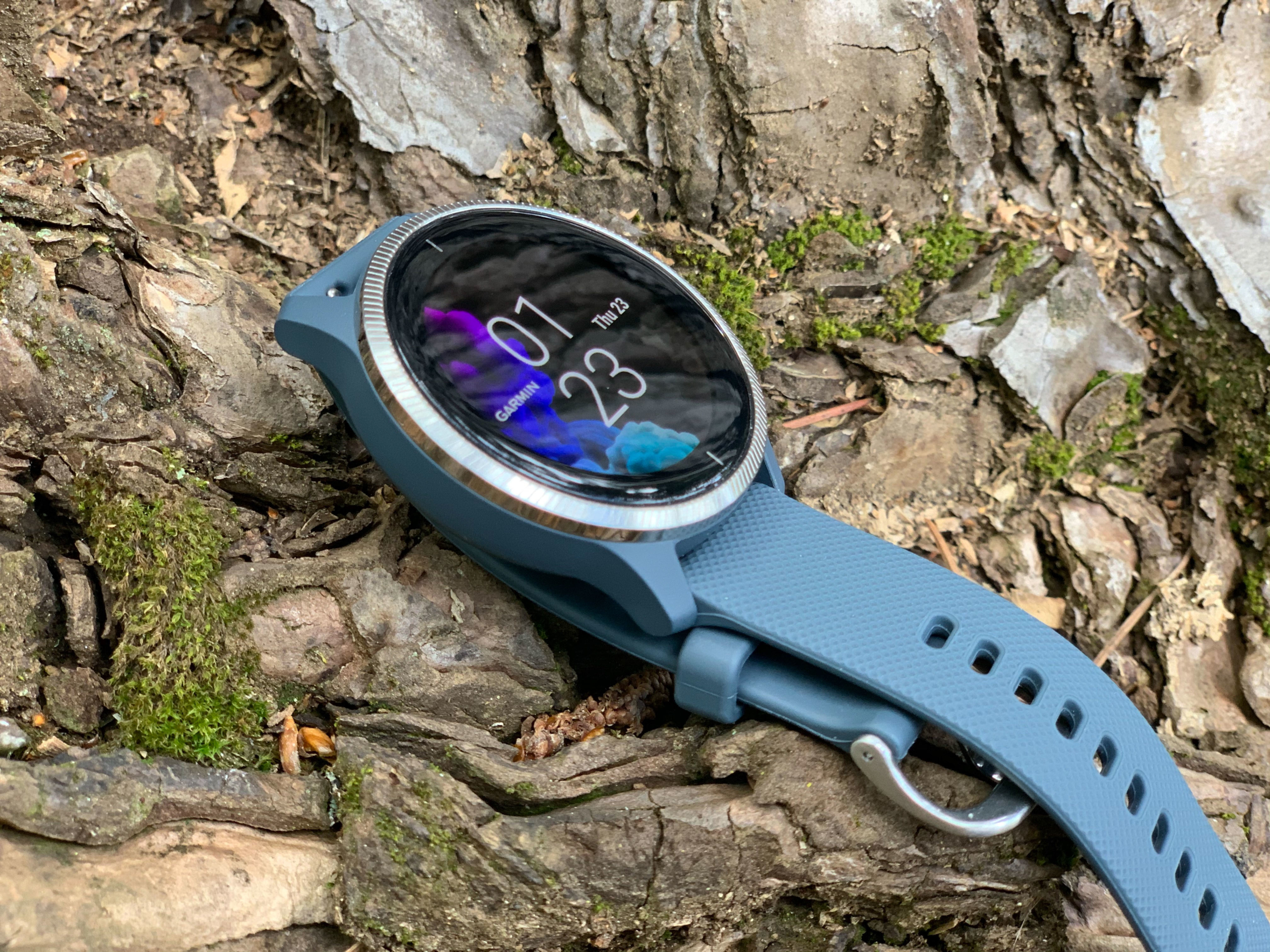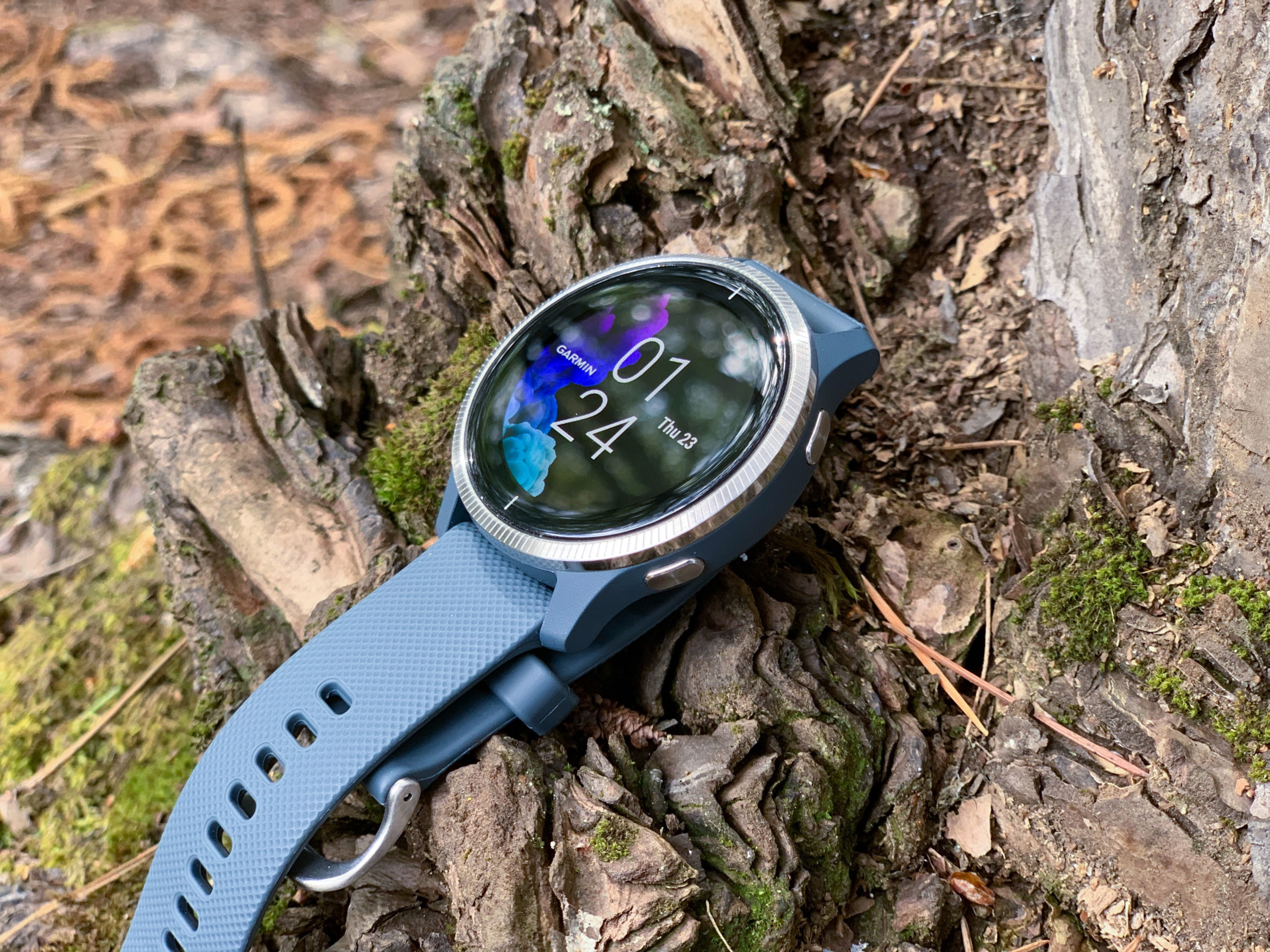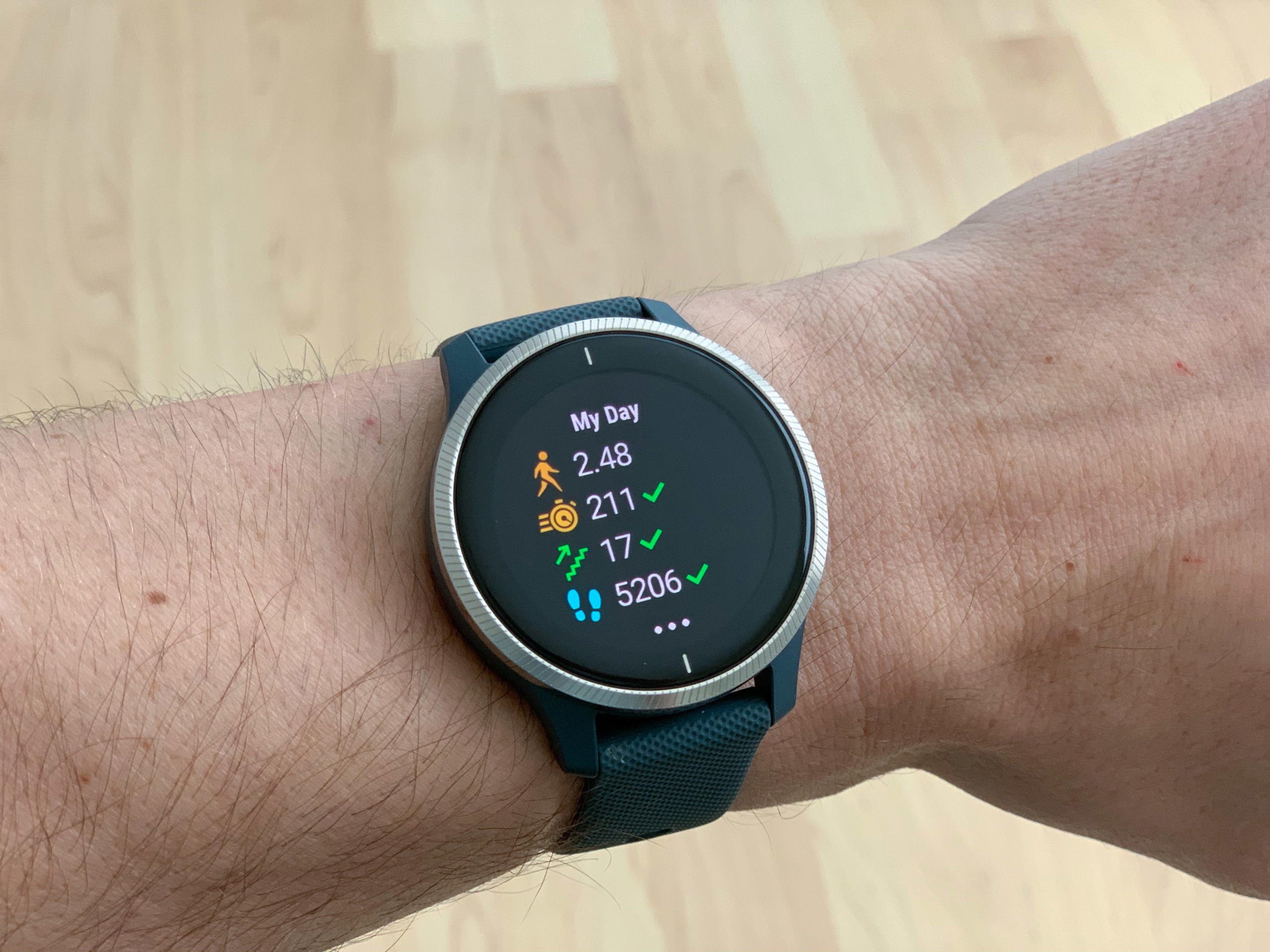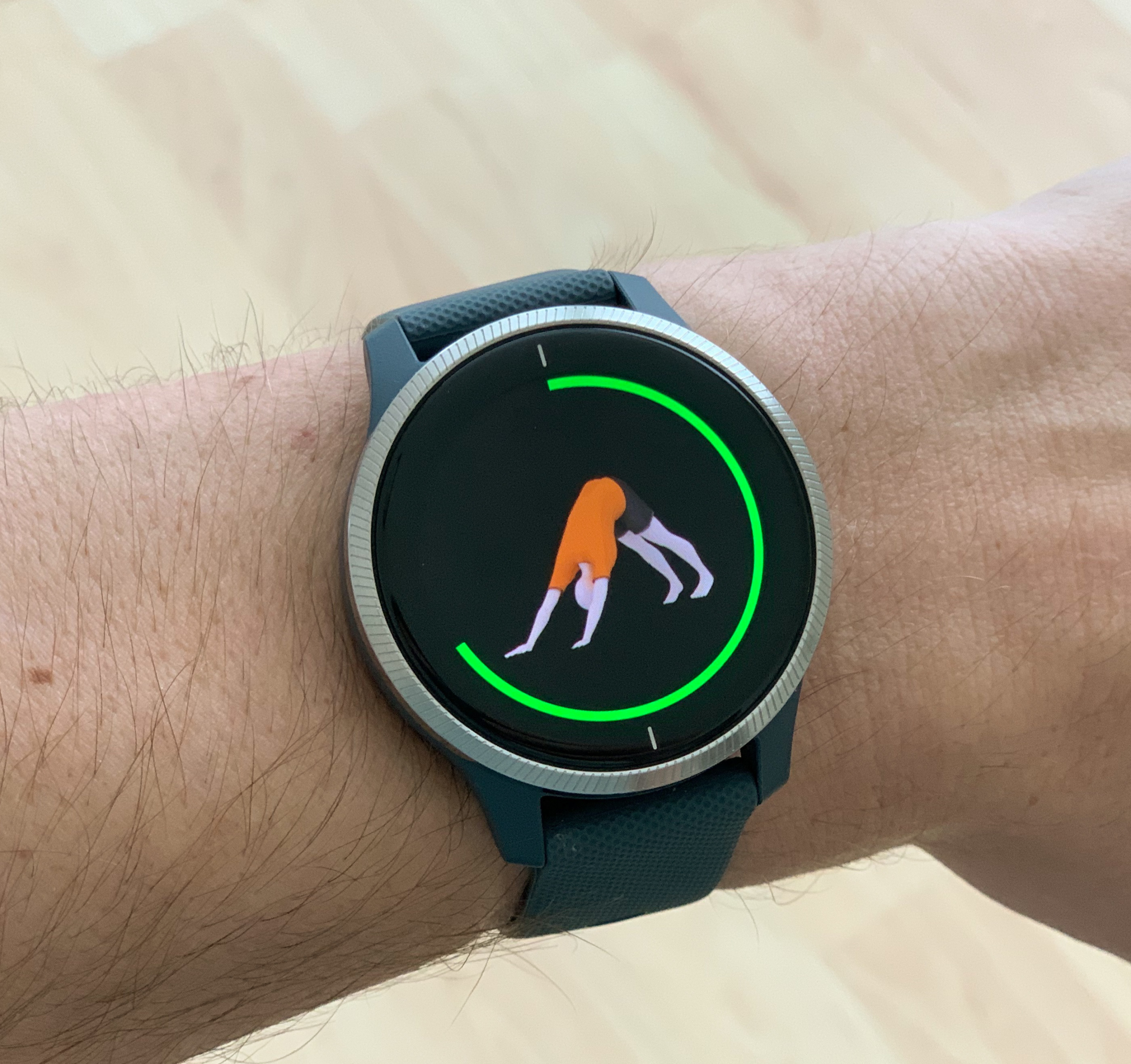“The Garmin Venu is a solid fitness tracker, but its gorgeous AMOLED display is the killer feature.”
- AMOLED Display
- Activity Tracking
- Workout Animations
- Loads of Sensors
- Lack of in-depth fitness metrics
- Lack of storage
The line between a smartwatch and a fitness watch continues to dissolve on a day-by-day basis.
It used to be that if you were interested in fitness you’d get a dedicated, nondescript fitness tracker with a super basic dot-matrix display (I’m looking at you, Nike FuelBand). Then Apple came out with their watch, and I remember thinking how silly it sounded. I mean, I already had a smartphone — wasn’t a smartwatch a little redundant?
Oh how the times change, and there’s no better example of watch evolution than the Venu from Garmin.
Display
The Venu is basically the same thing as the Vivoactive 4 — a multisport smartwatch that still has all the Wi-Fi and Bluetooth connections necessary for Android and Apple notifications. However, the Venu has a key difference in its display.

The Venu’s 390 x 390 pixel AMOLED display blows the Vivoactive’s 260 x 260 MIP display out of the water. While their physical sizes are similar at 1.2 inches and 1.3 inches respectively, the Venu’s screen has a far crisper picture with darker blacks and an array of colors that are surprisingly vibrant.
The newfound vibrancy of the Venu is shown off by its active graphics and watch faces, which are far better than most Garmin wearables. The Venu’s heart rate graph alone is a rainbow of color that made me eager to get in a workout just so my metrics would be more fun to look at.
Battery life
The only detriment of the AMOLED display is battery consumption, and you will more than likely end up frustrated if you don’t change the watch face setting to “always on” immediately.
I tried to live with the Venu on its default setting, which turns the display off automatically, to see if the battery life claims were true. Garmin claims 5 days of battery life in smartwatch mode and 6 days in GPS mode, or up to 20 days with both those modes turned off.
Yet I lasted just two days before I was infuriated with shaking my wrist like a crazy person to make the display light up. As a result, I set the display to stay on.
The penalty for the switch is more drain on battery life, but I still saw a little over 3 days of life with workouts every day, so this seemed like a worthwhile trade to maintain my sanity.
Design
Not looking to weigh things down, the Venu comes in at a scant 43 grams with a 43.2 by 43.2 by 12.4mm body. The size took me a few days to get used to, as I’ve become accustomed to large watches. This may be a deal-breaker for some, but with the Venu’s sharp display, I don’t feel like I’m missing out.
One of the best things about the Venu is that it has a touchscreen display. This makes for a more intuitive experience as you scroll through activities and daily stats, and with two physical buttons on the side, the Venu hits a happy medium of universal usability and familiarity for existing Garmin users.

Adding to the Venu’s usability is the inclusion of Garmin Pay for contactless payments, and storage for up to 500 songs. That number seems a little low compared to the Venu’s rivals, but since you can stream Spotify, Amazon Music, or Deezer it’s not that big of a deal.
On top of these features, the Venu has a calendar, weather, music control for your smartphone, and all the notifications you can ever ask for. While the usual “smart” features are covered, where the Venu shines (and all of Garmin’s past experience comes into play) is fitness tracking.
Fitness tracking
Garmin has loaded the Venu with sensors. On board is a GPS, heart rate monitor, barometric altimeter, compass, gyroscope, accelerometer, and pulse oximeter. This is nearly the same sensor array found on the higher-end Fenix 6 Pro, which also includes a thermometer.
All this sensitivity enables automated goals. The Venu learns your activity levels and starts setting daily goals based on your current activity. It can also track calories burned, floors climbed, intensity minutes, VO2 max, and energy and stress level estimates.
With all of this tracking, the Venu builds a fairly well-rounded look at your overall health and fitness. This is the ecosystem of metrics that diehard Garmin fans have come to know and love over the years, and with each firmware update, they continue to become more and more accurate.

The core competencies of the Venu lie in the usual suspects with running, swimming, and cycling. Running has pace and cadence tracking. Swimming has stroke detection, Swolf score, time, and distance alerts. Cycling has triggers for distance, time, and calories burned, along with the ability to connect with Garmin’s Varia radar and lights.
I had zero issues with tracking on any of the runs or rides I did. However, when it came to linking the Venu up with my indoor cycling trainer, it would connect but never recognize that I was pedaling. This wasn’t necessary, as the Venu still had my heart rate data, and I was tracking distance with Zwift. But it made for some odd workout logs that showed 0.00 miles.
Guided workouts
The Venu isn’t just about tracking what you do. It can also guide you through workouts.
The most interesting are the animations available for Yoga, Pilates, Strength and Cardio workouts. While there are multiple workout routines available, the option to build out your own specific workouts are there as well.
These animations are helpful because they prompt you to try something different. It felt a little clumsy at first, as I found myself trying to keep an eye on the watch for the next yoga pose. Over time, however, I learned when to glance at the watch and when to concentrate on my form.

Once you’ve completed an activity, the Venu estimates your sweat loss based on the metrics it has been tracking. While I’m a little dubious about how accurate this stat is, it had me thinking more about my hydration after even the smallest effort.
After a two-mile walk, the Venu estimated that I lost 201ml. That’s not much, but having the reminder tell me I could use a little something to drink was a welcome bit of mindfulness.
Stat tracking
For the stat junkies, the Venu has the all-important VO2 max score. Your VO2 max is essentially a measure of how well your body consumes oxygen, and is a relatively accurate way of establishing your baseline aerobic fitness.
True VO2 max tests are done by subjecting yourself to maximum efforts while your oxygen intake and carbon dioxide output are monitored with lots of tubes and expensive-looking medical equipment. I’m highly doubtful that the Venu can match a real VO2 max test’s validity, but most people won’t ever go to the extreme of getting a real test done, so the Venu’s estimate will have to do.
HR zones are what most people are going to be paying attention to, but I missed having more advanced metrics.
Unfortunately, the Venu is missing other important metrics that real fitness junkies will care about. Do you care about your current training or detraining status, whether you’re doing a base or threshold workout, or monitoring your weekly training load? Then keep moving, because the Venu doesn’t have any of that.
The Venu does have heart rate zones for managing efforts during workouts. HR zones are what most people are going to be paying attention to, but I missed having more advanced metrics.
I also missed route finding. The Garmin Fenix 6 Pro’s navigation is one of its strongest features. The Venu, on the other hand, only tracks where you went, and has no idea how to tell you where to go. The only exception is golfing, since the Venu has access to 41,000 courses that can be downloaded via the Garmin Connect App.
While the lack of navigation is kind of a bummer, the Venu continues its list of features with items like a sleep monitor for tracking your REM and deep sleep, as well as Incident Detection that will automatically send your location to designated contacts if it detects a crash while on a bike ride.
Warranty
Standard 1 year product warranty.
Our take
The Venu has a solid list of features that will cater to the vast majority of people who are fitness followers, but not fanatics. While you may miss out on some navigation and in-depth training metrics, the Venu’s streamlined design and beautiful touchscreen make it well worth the $350 price tag, and finding it on sale will make it all the more worthwhile.
Is there a better alternative?
The obvious alternative is the Apple Watch Series 5 at $400. Having the App Store available makes the Apple Watch extremely hard to beat if you’re already an iPhone user. But Garmin’s experience with fitness and the Venu’s touchscreen makes it a viable option for anyone not already fully engrossed in the Apple ecosystem.
How long will it last?
Garmin makes tough as nails products, but the Venu doesn’t have a raised bezel, so scratches on the Gorilla Glass screen are more likely than usual. That said, the Venu should last for several years at least.
Should you buy it?
Yes, if you use an Android phone. If you already own an iPhone, then pony up the extra cash for the Apple Watch Series 5, as its integration with the iPhone makes it a better choice.



